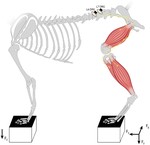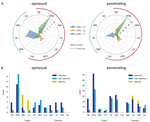 Anatomy of the spinal roots and periphery
Anatomy of the spinal roots and periphery
The dorsal root ganglia (DRG) are enlargements of the spinal nerve located bilaterally in the intraforaminal space at each spinal vertebral level. The DRG contains a heterogenous population of cutaneous, muscle and nociceptive afferents all of which can be further divided into receptor classes that convey specific information about the state of the limb. Thus providing a compact target for accessing large populations of somatosensory fibers.
Three to four ganglia account for the innervation of an entire limb while DRG at a single spinal level may provide access to the entire sensory representation of the foot. Importantly, the separation of the sensory and motor pathway at the spinal roots allows for stimulation of afferents in the DRG without concomitant stimulation of motor efferents which could directly activate muscles and contaminate a myoelectric control interface. Additionally, the spine provides mechanical stability, limiting the movement of the DRG and spinal cord, which may improve the stability of stimulation. DRG and DR stimulation can also be used with high-level amputations (above-knee, above-elbow) where access to peripheral nerves is limited. Several studies have focused on building encoding models for primary afferent activity at the DRG. These encoding models can be used to provide patterned biomimetic stimulation, while preserving the structure of information relayed to downstream sensory processing targets.

